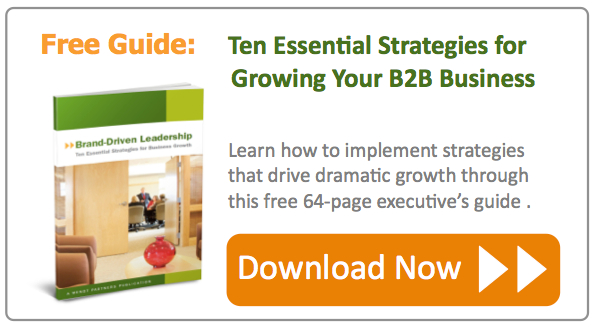Doug Wendt is a co-founder and senior partner with Wendt Partners.
Inbound marketing is one of the hottest concepts in business growth today. Built around a comprehensive vision for creating new customer relationships online, the idea behind inbound has evolved over the years but was largely evangelized and institutionalized thanks to Brian Halligan and Dharmesh Shah, the co-founders of HubSpot.
According to HubSpot, inbound marketing replaces outbound marketing (or "interruption" marketing) by delivering content and information that answers customers’ questions and attracts them to your business online.
Core components in the inbound methodology include blogging, keyword strategy, social media publishing and multi-channel online engagement. These steps attract new contacts who are then converted to leads on your website through calls-to-action, online forms, landing pages and downloadable content offers (such as eBooks, white papers, worksheets, checklists and buyer’s guides). You then further engage the leads and qualify them into becoming buyers through email workflows, sales-marketing alignment, personalization and multi-channel engagement.
Still, as consultants we tend to be skeptics when it comes to “all-in-one” strategies and vague promises of endless riches to be obtained by following one specific path to reach the end of the rainbow. In addition to the fact that marketing is just one of the four core focus areas we address through our business growth consulting process, we also believe that inbound marketing is one approach among many, and not the one and only approach above all.
here is no question that inbound marketing is a powerful and proven methodology that can become a major driver of new business for your company. In fact, Wendt Partners is an Elite HubSpot Partner and we implement HubSpot as the preferred business growth platform for our clients.
o that end, it’s important to understand what inbound marketing is really about — what it can and cannot deliver for your business. In order to help find the reality behind all of the hype, here are seven dirty secrets about inbound marketing that “they” (i.e. those who preach its capacity to solve all ills seemingly without limitation) don’t want you to know:
Dirty Secret #1: Inbound Marketing Requires Time. Lots of Time.
Inbound marketing requires an enormous commitment of time. And it requires this commitment in two ways.
First, it takes a lot of time to do correctly. Since the core objective is to create and distribute content that generates organic search results based upon the online behavior of your target prospects, you need to develop and distribute a nearly endless stream of content — and high quality content at that. Blog articles daily. Infographics weekly. Videos, podcasts and Slideshare presentations. Webinars and online chats. Constant social media updates, all tailored for each channel and audience segment. Guest editorials, customer interviews, and downloadable content. New landing pages and calls-to-action. Updated eBooks. In short: get ready to never sleep.
Second, it requires a lot of time to generate real results. Google doesn’t just crawl a few new web pages or blog articles and suddenly declare you a winner in the ‘top-of-the-first-page’ search results lottery. No, you need to earn that spot over time. A long time. Months and months, and maybe even a year (or two, or three). And you need to constantly continue generating new, shareable and linkable content in order to stay in that spot, all while you wait for the results to slowly ramp-up to your envisioned level of success.
Dirty Secret #2: Inbound Marketing Requires Money. Lots of Money.
Since inbound requires lots of time, it’s logical that it’s also very expensive. Time is not free. Nothing in business is free. Granted, you can download WordPress and start a blog tomorrow for ‘free’, but that doesn’t consider the most expensive element of all: labor. Labor costs will skyrocket if you do inbound correctly, because it takes a deep bench of talent to make it all work. Some experts estimate that an effective inbound marketing team for a small to midsize business consists of a minimum of three, and more likely a team of five professionals, all working on inbound full-time, together.
And then there’s the other side of inbound — pay-to-play. Sure, a few years ago you could deliver a post to your Facebook page and expect your followers to see it. Hah! Those days are over. Now you need to pay the piper and bribe Facebook to share your content with your own followers. Google’s conversion to the HTTPS protocol permanently ended the ability of millions of businesses to see where their online traffic was coming from. Now, you can still get that data - if you pay for Google AdWords. The game continues on every front…which is one reason why HubSpot added an ad buying platform to its latest product release.
Dirty Secret #3: Inbound Marketing Is Easy to Do Wrong.
It’s hard to do inbound if you don’t like to write or struggle to generate content ideas to begin with, but one other dirty secret is that inbound is easy to mess up. Google’s algorithms are constantly changing. Today’s smart linking strategy can quickly become tomorrow’s terrible technical mistake.
One person’s brilliant white-hat solution is another person’s underhanded black-hat technique that is sure to be banned by the search engines. Keywords are fickle and complex — especially when you puzzle over things like localized search or long-tail keyword research. The potential to mess things up is high, and you can quickly get in over your head.
Dirty Secret #4: Inbound Marketing Gets Harder to Do Over Time.
As more companies commit to inbound and more marketing is delivered the inbound way, something happens: it becomes harder to compete. Five years ago, there were a handful of inbound marketing agencies, and today there are over a thousand. The same is true with companies in every industry as more and more firms turn to inbound and content marketing as the key to their future growth investments.
In addition, there’s still no easy say to ensure that good content triumphs over bad. Sure, the search algorithms seek out tricks and cheats constantly — but there’s always another approach or technical ‘loophole’ that someone is exploiting behind your back.
Dirty Secret #5: Inbound Marketing Generates Lots of Terrible Leads.
The great promise of inbound in many cases boils down to this: Do inbound marketing, and you’ll generate a virtually endless supply of new sales leads for your business. Who doesn’t want infinite new sales leads? No one! Everyone wants that holy grail. Unfortunately, if it sounds too good to be true, it probably is.
Assuming you get over the hurdles already mentioned, it is absolutely true that you can generate a consistent flow of new leads online. But let’s first define what a lead is. For most B2B companies, a lead means something more than “Hey, I liked that article so sure, I’ll give you my email address and then download this checklist”, but to inbound marketers, that’s a lead — and so is every other online inquiry you ever receive.
Oh, and then there’s the question of what to do with all of the fake data that people input just to get to your free downloads. What do you mean “John Doe” isn’t the person’s actual name and they used a Gmail account instead of a real business email address?
Dirty Secret #6: Inbound Marketing Can Quickly Mess Up Sales.
So, if you do generate all of these inbound leads, then there’s the issue of dealing with them. Ignore them, and you’re throwing away your inbound investment. Focus on them first and foremost, and you can potentially drive your sales team insane.
In addition to making them trudge through lots of bad data or weak inquiries, there’s the reality that in order to properly prepare leads for sales, you really need to work them through a three-level process that HubSpot describes along the lines of a funnel: top-of-the-funnel, middle-of-the-funnel, and bottom-of-the-funnel. Of course, only the bottom ones are ‘sales-ready’ which means that marketing still has a lot more work to do with the rest of them.
Dirty Secret #7: Inbound Marketing is Not the Fastest Way to Grow Sales.
Perhaps the greatest dirty secret of inbound marketing is that in most cases, it is absolutely not the fastest way to grow sales. In fact, it is in many cases the longest, slowest, most time-consuming way to grow sales.
That’s because most B2B companies don’t really need more leads tomorrow, despite their desire to have them (just like the desperate salesmen in the classic David Mamet play (and movie), Glengarry Glen Ross. What does the VP of Sales (played by Alec Baldwin in the film version) tell the sales reps? Before they are to be given new leads, they first have to prove that they’ve generated all the business they can…from the leads they’ve already been given.
Guess what? It’s true. Research shows that many B2B companies can literally double their sales revenues just by properly engaging with their existing contacts.
How Inbound Thinking Can Actually Fuel Your Business Growth Strategy
Yes, inbound marketing is hard...very hard. It's an enormous investment in the future of your business, and many business owners go into it with unrealistic expectation and inaccurate assumptions. We're not saying it doesn't work (properly executed, it can be extraordinarily successful). What we are saying is that doing it right requires commitment, investment and readiness at a level that many of its advocates have been less-than-honest about.
One of the best ways to achieve that readiness and ramp up your marketing in a manner that makes more sense is to use inbound marketing methods, but apply them to your existing contacts first. This is often the best solution of all. Go ahead and create that outstanding content, but tailor it for your current business contacts and customers, before worrying about attracting new ones. Use the inbound methods, but apply them to close more business from existing relationships first, and worry about generating more brand-new leads second.
Not only does this focus you on more near-term opportunities, but it also gives you the strongest foundation for expanding your efforts with a future focus on new lead generation as well.
The good news is that this is now possible, thanks to HubSpot’s decision to build a complete sales CRM system inside the platform. Now, HubSpot truly can serve as an end-to-end business growth platform for your company.
Taking a blind, non-strategic leap into inbound marketing is probably not the best next step for your company, but developing and implementing a comprehensive business growth strategy that encompasses integrated inbound probably is.
Now that you know the truth about inbound, you’re in a much better position to think honestly about the future of your business, and how you can drive new sales growth tomorrow, starting with the valuable business relationships you generated today.
Want to learn more about how to develop the right digital strategy for your business? Take the next step by reading "Good, Better, Best: How to Choose the Right B2B Digital Strategy".
Image Credit: Flickr @ Creative Commons








